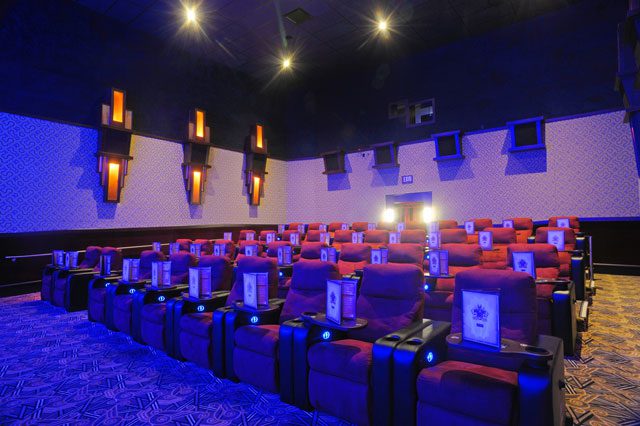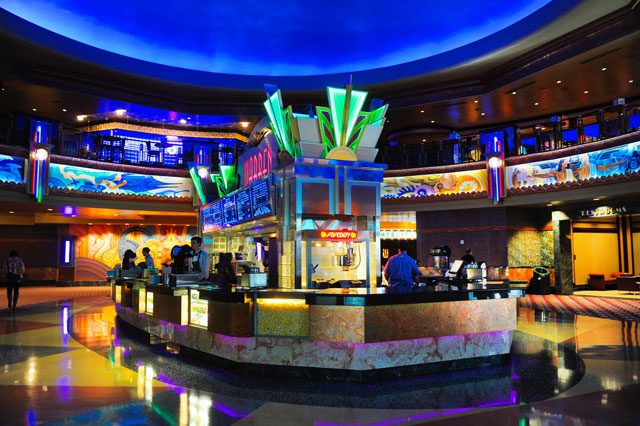
[dropcap]Summer[/dropcap] is known as the season of blockbuster movies, but for Oklahomans who are looking for a different experience – whether that comes from a wider selection of movies or watching the biggest movies in more comfort – there are multiple options available.
Art House Cinema
Both Tulsa and Oklahoma City are homes to theaters dedicated to bringing in independent films that might not be available in the state otherwise. In Tulsa, Circle Cinema, an independent and nonprofit theater, works to provide a more in-depth experience by hosting discussions or question and answer sessions with people involved with the film.
“We like to make it about more than the movie,” Circle Cinema President and Co-Founder Clark Wiens says. “We can’t always do that, but we like to find someone in Tulsa who can talk about it. If we can’t do that, we’ll try to get someone to Skype in.”
Wiens says the staff works constantly to find films that are interesting to people in Oklahoma, whether it be through connections with the state or by the topic. The staff goes to film festivals every year, looking for independent films that have a Tulsa twist to them and attempt to premiere them in town.
The cinema worked with a foundation to provide screenings of Bully, a 2012 documentary about how bullying affected five children and their families. Around 3,000 to 4,000 students ended up seeing the movie. Wiens says the cinema isn’t taking individual credit for the project, but is proud to have been part of it and enjoys the opportunity to bring movies that provoke thought in viewers.
“We bring those films thinking people might walk away with a mind-changing idea,” he says. “We strongly encourage people to stay behind and talk about the film, and we have a lobby just for people to sit and talk.”
The Oklahoma City Museum of Art Samuel Roberts Noble Theater is the only art house venue in Oklahoma City, and film curator Michael Anderson says the theater provides the community access to film and movies they wouldn’t have a chance to see anywhere else on the big screen.
The museum has one screen and holds around 400 screenings a year, showing 100 to 150 new films annually.
“In general, we do have a very passionate public that’s quite loyal to us,” Anderson says. “Oklahoma City viewers in particular are actually quite adventurous and enjoy films that are more challenging in how the stories are told. We get big audiences for very difficult films.”
The theater also attempts to program films that tie in with the exhibits in the theater. Anderson says the theater is programming films that will complement the museum’s Matisse in His Time exhibit that opens June 18, including French films, films about Matisse and a film which has a color palette inspired by Matisse.
Visitors can also buy tickets that give them access to other parts of the museum, such as the “Art after 5” events that provide access to the rooftop bar or “Dinner and a Movie” packages that include dinner in the Museum Café.
In addition, Anderson says the museum has a full bar that caters the screenings. The museum is also planning to launch a film society that will provide discussion after films and question and answer sessions with directors and filmmakers.
Circle Cinema and OKCMOA have a reciprocal admission agreement, so anyone who is a member of one theater will receive the membership discount at both venues.
Cinema in Style
People who are looking for more traditional summer movies but would like to make the experience a little more special also have options in both the Tulsa and Oklahoma City areas. Warren Theatres, with locations in Moore and Broken Arrow, has built a reputation for providing luxury accommodations for filmgoers.
“[Company owner Bill] Warren was very specific that he wants people to come in and, once they step into the lobby, the first thing out of their mouth is, ‘Wow,’” says Dan Gray, vice president of operations for Warren Theatres. “He feels that is exactly what his customers should expect when they step into his theaters because they’re coming in to escape reality for a while.”
While the entire theater was built to be impressive, two options are also provided to create a more comfortable environment than people receive with a standard movie ticket. Balcony seating in the the largest auditoriums have loveseat-style seating and a straight ahead viewing angle of the screen, and the Director’s Suites are smaller, more intimate and more exclusive, Gray says.
Both types of theaters have a full service wait staff to bring people popcorn, drinks or dinner.
“They’ll take care of you so you don’t have to stand in line at the concession stand,” Gray said.
For parents who would like to take their children to a movie but worry about them getting restless, the two largest auditoriums in Broken Arrow and Moore provide special rooms parents can take their children to so they can finish the movie and not have to leave the theater. The enclosed rooms have large bay windows and separate volume control knobs.
Moviegoers also have options to see the latest releases without ever leaving their cars – the Admiral Twin Drive-in in Tulsa, which is celebrating its 60th anniversary this year, and Winchester Drive-in in Oklahoma City are two of a handful of drive-in movie theaters still operating in the state.
Both are open on weekends only and require an FM radio to hear the movie’s audio. The Admiral Twin Drive-in is currently open, and the Winchester Drive-in expects to be open by the beginning of this month.




























